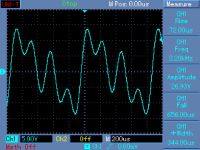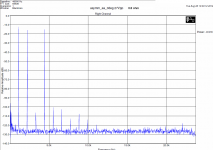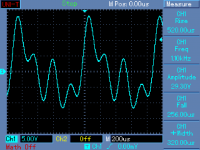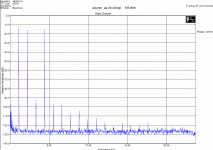They always swing from academic to semantics D, my explanation was straight forward and laid out as to what power level we were testing at and why we felt VCID was not an issue in your typical hi-fi domestic situation.
I was promised numbers , waiting , Frenchie will be back ....
I was promised numbers , waiting , Frenchie will be back ....
To put some ballpark numbers on it, my experiences indicate that a 100% competent 60W amplifier driving average sensitivity, 90dB speakers is sufficient for domestic listening - with the right source material, this combination will give you shouting at the top of your voice to be heard SPLs, and get your ears ringing within 5 minutes, quite enough I would suggest ... 
never said that , so go ahead and quote me , should be easy ...
ok
Vacu,
Have you ever measured this , decades and i have never seen VC temp as an issue with domestic speakers... this is really an issue when doing sound reinforcement.
IMO this is a non issue in domestic operated speakers, operating close to the voltage rating on xover caps is a bigger concern with heat and distortion...
Have you measured or is this Wikipedia....
Again you say loud , i said domestic , have you ever measured how much power is required to raise VC TEMP to 150, i have measured while testing and have never seen such temps

lol, yes over voltage , who would have thunk it ...Now anyone with 150C VC temps ...

...in the past i had done alot of testing on this and could not determine this was an issue for domestic used speakers.
addressing Strawman VC argument :
...Additionally VC temps were measures with infra-red therm and increase in temps over ambient were minimal (1-8 deg) and cool down was almost instantaneous
...My conclusion at the time ( 18yrs ago) and still such today is... most quality drive units do not suffer from high VC
Dont be so hard on yourself, feel free to show how you arrived at 150C, i know it's easier for you to deflect..
...
These guys need to actually measure instead of this strawman argument, we have only seen VC temp issues in PA sound reinforcement setups, at obscene RMS levels, not domestic...
I SAID IN DOMESTIC APPLICATION we could not measure or detect VC temp to be an issue.
...There is no burning of VC at typical domestic listening levels , never , sold hundreds of prs of speakers for domestic use never had one fail in the field.
...we tested ... and in practical use torture testing we have used in an attempt to see if we had issues , pushed amps to clipping when testing on music, we had no such issues or damage..
Any of those ring a bell?
I said never in a domestic hi-fi environment, never said you couldnt burn up a driver , i said at up to 32 watts rms , we could not measure dynamic compression, in your case it must have been 30% thd and no music, possibly PA disco use too , not what we were discussing , read back ...
No, not PA disco use, but undoubtedly a loud house party.
I understood what you meant to say, but I also read what you actually wrote. You were very clear that 150C VC temp was not possible in a "domestic" setting, because that's what your measurements told you. Apparently when you do the measuring, measurement trumps experience and theory, while when others do the measurements, your experience trumps the measurements.
But that's OK Wayne, I really like watching the dance.

...
Apparently when you do the measuring, measurement trumps experience and theory, while when others do the measurements, your experience trumps the measurements. ...
That happens A LOT, and not only here, either.
I don't believe in magic or voodoo, but I cannot be in denial about something that is theoretically not possible when it's happening right in front of my eyes, and repeatedly.
As an example, my wife hates computers, and they hate her back. I have seen her do things which are not supposed to be able to be done, in fact which blatantly contradict the user manual's claims. Things which I later tried to replicate, but never could. And on more than one occasion. How and why - frankly, I wish I knew, but I haven't the foggiest of ideas.
Not to even mention the situations when the math says that should be a 4k7 resistor, and the damn thing won't work, but if I change that to say 7k5, it works like a charm, when theoretically it should be gasping and struggling for current.
...... basic culmination of knowledge for audio applications I wrote with
W.Jung in Audio magazine many decades ago.
seems difficult, to think of, '3', as many.
50, maybe ...
--
still have my copy(s).
possibly the most interesting, and useful article,
this poster has encountered thus far,
about audio equipment.
i'd like to convey my thanks, to you, and Mr. Jung.
that article has made a huge difference.
But that's OK Wayne, I really like watching the dance.

Here, have some popcorn
Jan
Does it exist in electronic form?
If so, a link would be much appreciated.
I believe Walt has it on his new website at http://www.waltsblog.waltjung.org
Last edited:
Will some differ when the polarities are reversed?
THx-RNMarsh
I have tried a real life test. Input signal is 1st 100%, 2nd 70% and 4th 70% (relative amplitudes). Two cases, all harmonics in phase (phase shift 0 deg) and second case is 1st harmonic with 45° phase shift. The second one results in asymmetric wave.
Results attached, first for 0° phase shift, symmetric wave.
Attachments
Asymmetric wave, phase shift 45°. Please note that amplitude spectra of symmetric and asymmetric waves are identical (input signal spectra). We can see some differences in spectra at amplifier output, due to different amplitude stress and amplifier nonlinearity.
Attachments
Frenchie ,
JBL :
600 W AES continuous pink noise
Sensitivity: 97 dB SPL, 1 W, 1 m (3.3 ft)
Frequency Range
: 30 Hz - 2.5 kHz
Power Compression:
at –10 dB power (60 W): 0.7 dB***
at –3 dB power (300 W): 2.5 dB
at rated power (600 W): 4.0 dB
@ 60 watt power compression on their bass unit is .7db, consistent with what we found 20 yrs ago, when testing RMS below 32 watts and consistent also when used in typical domestic hi-fi, VCID would not be an issue.
60 watts RMS would translate to over 720 watts peak power when used in domestic hi-fi situation. even you head banging nutters couldn't go there ..
Thank you for proving my point.
If all this compression were due to thermal resistance increase, this would correspond to VC temperatures of 43, 197 and 387 degrees K above ambient. Obviously, their are mechanical non-linearities in the suspension which also produce compression, but it gives you a sense of the numbers.
Now, with this example, you used a professional JBL driver that can handle 600 Watts continous noise power. Typical drivers in living room speakers will handle less than 60 Watts noise power. 30 Watts is even optimistic for most.
About your 'test' I vented some doubts earlier (posted at #56027). How can you go from 1 to 16 Watts without an increase in distortion or impedance? All drivers have increasing distortion with increasing power. You should have seen impedance increase as well. It looks like you pulled these results out of your brown star.
Last edited:
Pavel
Have you tried the same ratios at a lower frequency to identify the thermal component?
Just tried. No thermal components, with signals down to 10Hz. With signals down to 1Hz FFT resolution is insufficient.
Does it exist in electronic form?
If so, a link would be much appreciated.
http://waltjung.org/PDFs/Picking_Capacitors_1.pdf
http://waltjung.org/PDFs/Picking_Capacitors_2.pdf
George
Asymmetric wave, phase shift 45°. Please note that amplitude spectra of symmetric and asymmetric waves are identical (input signal spectra). We can see some differences in spectra at amplifier output, due to different amplitude stress and amplifier nonlinearity.
Pavel, I spent some time years ago with this asymmetric signal stuff and could not get through to anyone involved. The question is topology signature or just bad design signature, IMHO positive results were obtained when full power bandwidth was reached/exceeded (old news). This should rest with testing the uA741 for audio.
Last edited:
A.wayne,
Could you tell us how you did those thermal temperature measurements with an infra-red device. Was the dust cap removed to see the gap temps? What about a time factor in those measurements? I would love to believe that I could just forget about the temperature rise it would mean I could just use the lowest curie point magnets and forget about demagnetization. Motor mass will definitely affect the results over time and the maximum temp reached but in a small consumer motor you will also have much less mass to absorb any heat to dissipate. One factor we have to look at is the diaphragm area and excursion needed to produce a certain sound pressure level, it won't take much with a 15" cone in a house to get really loud but a smaller 6" or 8" speaker is going to have to work much harder to reach those same sound levels and much more input power to the voicecoil. We also have to consider voicecoil diameter in all this.
I don't want to get into an argument about this, I really want to understand under what conditions your measurement were made.
Could you tell us how you did those thermal temperature measurements with an infra-red device. Was the dust cap removed to see the gap temps? What about a time factor in those measurements? I would love to believe that I could just forget about the temperature rise it would mean I could just use the lowest curie point magnets and forget about demagnetization. Motor mass will definitely affect the results over time and the maximum temp reached but in a small consumer motor you will also have much less mass to absorb any heat to dissipate. One factor we have to look at is the diaphragm area and excursion needed to produce a certain sound pressure level, it won't take much with a 15" cone in a house to get really loud but a smaller 6" or 8" speaker is going to have to work much harder to reach those same sound levels and much more input power to the voicecoil. We also have to consider voicecoil diameter in all this.
I don't want to get into an argument about this, I really want to understand under what conditions your measurement were made.
Many thanks, George, that's EXACTLY what I was looking for.
- Status
- Not open for further replies.
- Home
- Member Areas
- The Lounge
- John Curl's Blowtorch preamplifier part II



